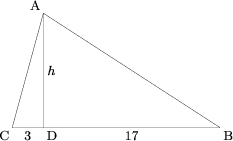Difference between revisions of "1988 AIME Problems/Problem 7"
m |
m (Fixed some spelling and grammar) |
||
| (7 intermediate revisions by 6 users not shown) | |||
| Line 1: | Line 1: | ||
| − | |||
| − | |||
== Problem == | == Problem == | ||
| + | In [[triangle]] <math>ABC</math>, <math>\tan \angle CAB = 22/7</math>, and the [[altitude]] from <math>A</math> divides <math>BC</math> into [[segment]]s of length 3 and 17. What is the area of triangle <math>ABC</math>? | ||
== Solution == | == Solution == | ||
| + | <center>[[Image:AIME_1988_Solution_07.png]]</center> | ||
| + | |||
| + | Let <math>D</math> be the intersection of the [[altitude]] with <math>\overline{BC}</math>, and <math>h</math> be the length of the altitude. [[Without loss of generality]], let <math>BD = 17</math> and <math>CD = 3</math>. Then <math>\tan \angle DAB = \frac{17}{h}</math> and <math>\tan \angle CAD = \frac{3}{h}</math>. Using the [[Trigonometric_identities#Angle_Addition.2FSubtraction_Identities|tangent sum formula]], | ||
| + | |||
| + | <cmath> | ||
| + | \begin{align*} | ||
| + | \tan CAB &= \tan (DAB + CAD)\\ | ||
| + | \frac{22}{7} &= \frac{\tan DAB + \tan CAD}{1 - \tan DAB \cdot \tan CAD} \\ | ||
| + | &=\frac{\frac{17}{h} + \frac{3}{h}}{1 - \left(\frac{17}{h}\right)\left(\frac{3}{h}\right)} \\ | ||
| + | \frac{22}{7} &= \frac{20h}{h^2 - 51}\\ | ||
| + | 0 &= 22h^2 - 140h - 22 \cdot 51\\ | ||
| + | 0 &= (11h + 51)(h - 11) | ||
| + | \end{align*} | ||
| + | </cmath> | ||
| + | |||
| + | The positive value of <math>h</math> is <math>11</math>, so the area is <math>\frac{1}{2}(17 + 3)\cdot 11 = \boxed{110}</math>. | ||
== See also == | == See also == | ||
| − | + | {{AIME box|year=1988|num-b=6|num-a=8}} | |
| − | + | ||
| − | + | [[Category:Intermediate Trigonometry Problems]] | |
| + | {{MAA Notice}} | ||
Revision as of 19:20, 27 February 2018
Problem
In triangle ![]() ,
, ![]() , and the altitude from
, and the altitude from ![]() divides
divides ![]() into segments of length 3 and 17. What is the area of triangle
into segments of length 3 and 17. What is the area of triangle ![]() ?
?
Solution

Let ![]() be the intersection of the altitude with
be the intersection of the altitude with ![]() , and
, and ![]() be the length of the altitude. Without loss of generality, let
be the length of the altitude. Without loss of generality, let ![]() and
and ![]() . Then
. Then ![]() and
and ![]() . Using the tangent sum formula,
. Using the tangent sum formula,

The positive value of ![]() is
is ![]() , so the area is
, so the area is ![]() .
.
See also
| 1988 AIME (Problems • Answer Key • Resources) | ||
| Preceded by Problem 6 |
Followed by Problem 8 | |
| 1 • 2 • 3 • 4 • 5 • 6 • 7 • 8 • 9 • 10 • 11 • 12 • 13 • 14 • 15 | ||
| All AIME Problems and Solutions | ||
The problems on this page are copyrighted by the Mathematical Association of America's American Mathematics Competitions. 









